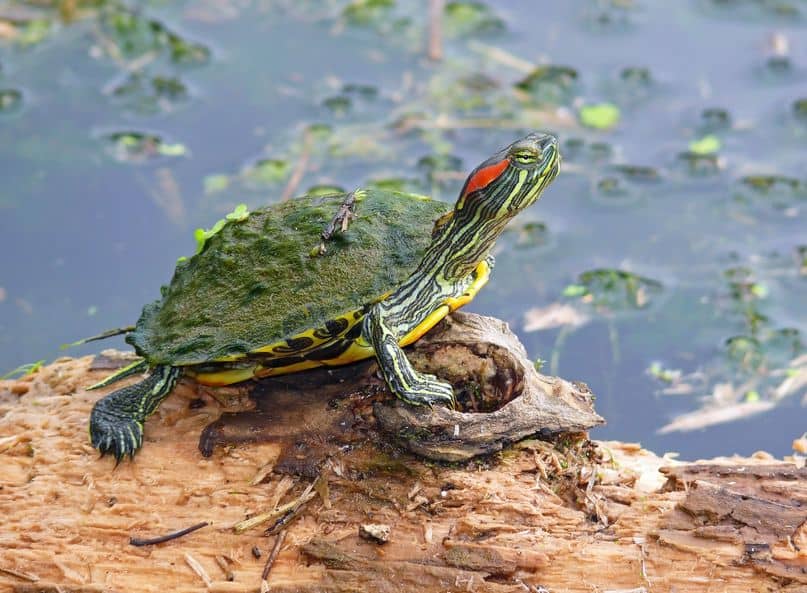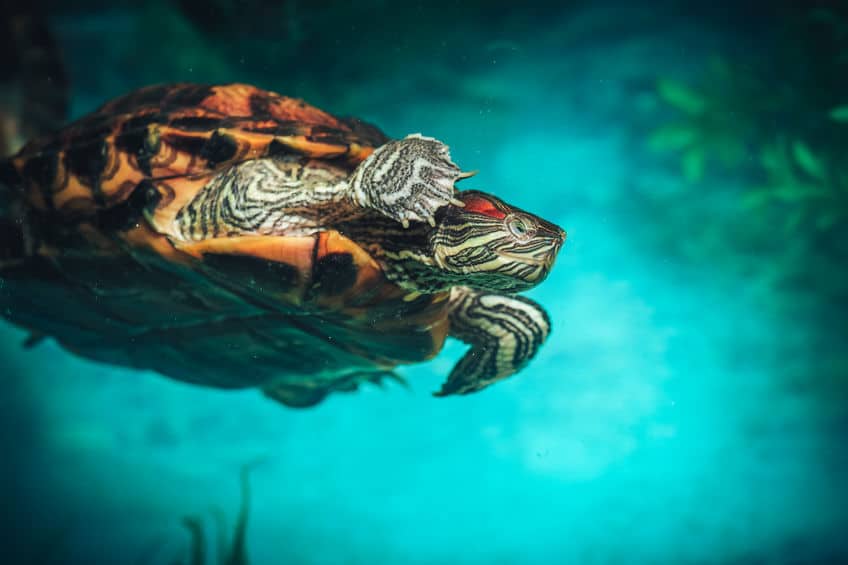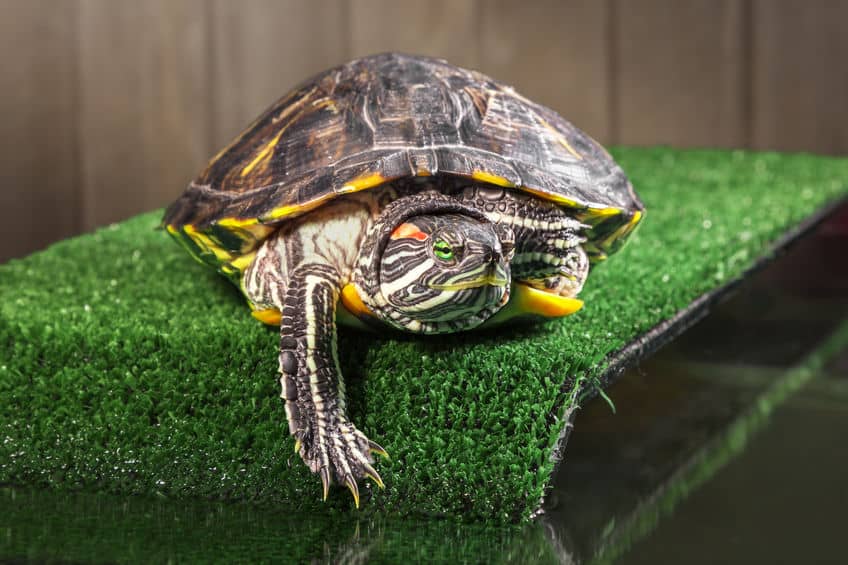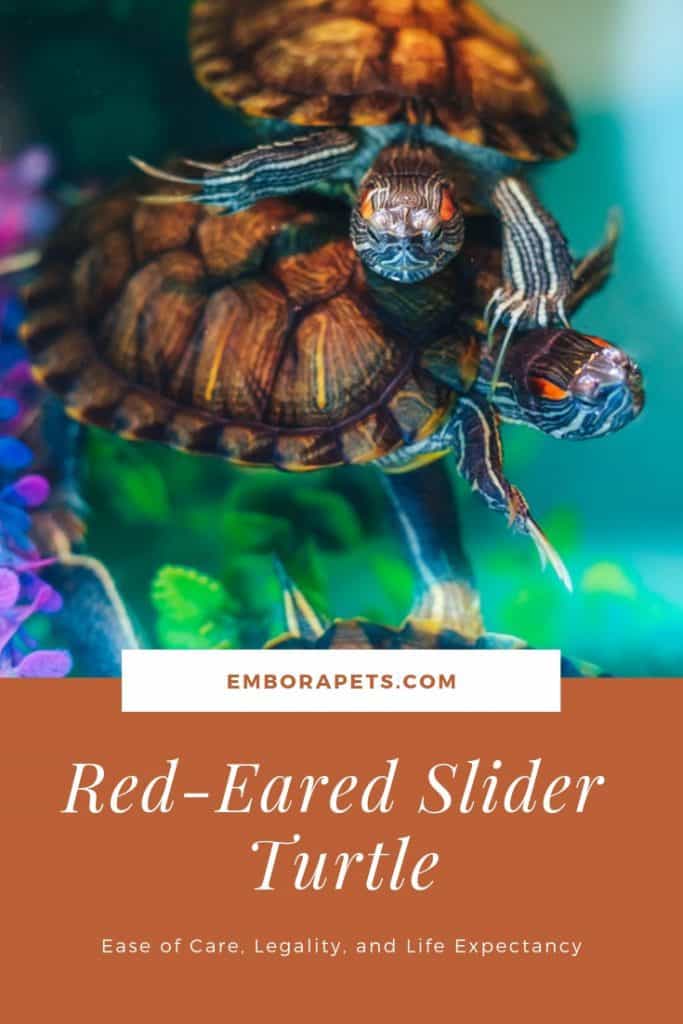Red-Eared Sliders as Pets: Ease of Care, Legality, and Life Expectancy

Turtles, red-eared sliders, in particular, make great pets, but the availability of these pets has been called into question with certain legalities that have come up. So I did some research on the legality, life expectancy, and ease of care for these common household pets.
Can you keep red-eared sliders as pets? Red-eared sliders have commonly been kept as pets because of their long lives and their easy care, but recently these household pets have been banned in many states and require certain tests in others before ownership is allowed.
Turtles, including the red-eared sliders, stay in their terrariums, eat, and are relatively easy to care for, but their connection with salmonella outbreaks have made them hard to obtain in many states.
Below there is a description of how these turtles are as pets and all of the facts that come with potential ownership.
Red-Eared Sliders as Pets
Turtles have been popular pets for a long time. I remember hearing stories when I was growing up about my mum’s pet turtle that she had while she was growing up.
They are cute, rather easy to take care of, and kids can have easy responsibilities when it comes to the feeding of red-eared sliders. Most turtles are easy to feed which allows kids to help.
Red-eared sliders have a royal reputation as they were one of the first turtles that were sold and kept as pets. People fell in love with these turtles and made them a part of their family. Now, it is not always as easy.
Life Expectancy and Characteristics
You might be wondering what the big huff is about red-eared sliders and why so many people love them. Well, they are quite unique looking turtles and have some very distinctive features that make them popular.
For example, they have these two little red dots that are located behind each eye on the side of the turtles head. People say that they look like little red ears, hence their name.
These creatures are also very good at escaping predators because to the first sound of danger these turtles will slip into the water faster than is recognized.
Another reason that people have fallen in love with red-eared sliders, is because of their incredible size. Although they start out rather small, sometimes less than 4 inches, they grow to be rather big turtles.
The Shell or the carapace of a Red-Eared Slider will be firm and hard if they are healthy.
Females can grow to be 12 to 15 inches in length while male red-eared sliders can grow to be around 8 to 10 inches long. That being said both of these ranges are on the larger side of the spectrum for their sex.
It is common for Females to reach about 10 inches while males stay around 8 inches. So, not all of the red-eared sliders are giant, but quite a few of them are.
Although female red-eared sliders are large, the male red-eared sliders have longer claws and tails than the females do. This can help to identify the different sexes.
Red-eared sliders are quite the opposites of humans. As humans males are normally larger with short nails, while the females usually grow out their nails and are quite a bit smaller than the males.
These turtles are also considered to be very beautiful because of their green color and the painted yellow lines that run all over their bodies. This look makes them very popular for turtle lovers all over.
They are also very common turtles and are found in the United States, Canada, and a few other countries. Because of this, they are not very expensive which makes them a hot commodity.
They normally sell anywhere from five dollars to twenty-five dollars depending on which state you live in and the regulations that are in place in each state.
As male Red-Eared Sliders get older, their skin darkens. Older Red-Eared Sliders can look almost black because of age.
The cheaper the turtle the smaller it normally is and it is probably un-sexed which means that in half of the states they will probably be about 20-25 dollars because they are sold bigger and have stricter regulations.
In the wild, red-eared sliders can live to be 40 years old, which is a nice long life. In captivity though, red-eared sliders typically live around 11 years but if you are very careful with them and nurture them they can live to about 40 years.
What Legal Issues come with Red-Eared Sliders?

Although red-eared sliders have been popular in the United States for many years, with new technology and developments this peaceful animal has become one of the most talked about pets.
There are quite a few states that have laws specifically against the purchasing or selling of red-eared sliders that are based on federal law. And all because they found out these turtles were making people sick.
Around 1975 it was discovered that turtles carry salmonella and that they were spreading the disease to their owners and other who come into contact with the turtle or something the turtle had touched.
Turtles don’t only carry salmonella but it also spreads from them and affects surfaces and objects. So people didn’t even have to touch their pet turtle to contract salmonella, they just had to touch something that had been infected with salmonella.
| Small Turtle Bans | Complete Bans | Large Turtle Warnings | Certified Salmonella Free | |
| Alabama | ||||
| Alaska | ||||
| Arizona | ||||
| Arkansas | x | |||
| California | x | |||
| Colorado | x | |||
| Connecticut | x | x | ||
| Delaware | ||||
| Florida | x | |||
| Georgia | ||||
| Hawaii | ||||
| Idaho | ||||
| Illinois | x | |||
| Indiana | x | |||
| Iawa | ||||
| Kansas | ||||
| Kentucky | ||||
| Lousiana | x | |||
| Maine | ||||
| Maryland | x | |||
| Massachusetts | ||||
| Michigan | x | |||
| Minnesota | ||||
| Mississippi | x | |||
| Missuri | ||||
| Montana | x | |||
| Nebraska | ||||
| Nevada | ||||
| New Hampshire | x | |||
| New Jersey | x | x | ||
| New Mexico | ||||
| New York | x | x | ||
| North Carolina | x | |||
| North Dakata | ||||
| Ohio | ||||
| Oklahoma | ||||
| Oregon | x | |||
| Pennsylvania | x | x | x | |
| Rhode Island | x | |||
| South Carolina | ||||
| South Dakota | x | |||
| Tennessee | x | |||
| Texas | ||||
| Utah | x | |||
| Vermont | ||||
| Virginia | ||||
| Washington | x | |||
| West Virgina | ||||
| Wisconsin | ||||
| Wyoming |
Red-eared sliders were some of these culprits. In the year 1975, the Food and Drug Administration has set up regulations limiting the sale of small turtles that came with certain exceptions like zoos and other places.
Not all states adopted these laws and some states wrote their own laws using these regulations. North Carolina and South Dakota have laws that ban all turtle sales completely.
There are 18 states in total that either adopted the Federal standards or made their own standards restriction the selling and purchasing of small turtles in their state.
Illinois, New Hampshire, and Pennsylvania all adopted the federal regulations while the other 15 states made up their own laws regarding the sale of turtles whose shells were smaller than 6 or 4 inches.
Arkansas made the law that turtles with shells that were 6 inches or less couldn’t be sold or purchased in their state. The other 14 states took pieces of the federal restrictions and made their own laws regarding the purchase or sale of any turtle whose shell was 4 inches or less.
That meant that baby red-eared sliders whose shells were either 6 inches and less or 4 inches and less could no longer be bought and sold in those particular states.
A few states made different laws creating restrictions on turtles being sold or purchased that were 6 inches or larger. All of these things were done in the hope to prevent the spread of salmonella.
Five more states made laws that required that the turtles being sold there were salmonella-free or they would kill them. And other states just put regulations on children and public places with turtles.
There are other reasons that some states banned the sale of red-eared sliders specifically. Florida, for instance, has laws only on red-eared sliders turtles only and no other regulations on turtle sales.
In Florida, people were letting their red-eared sliders go free in the wild which started causing a lot of problems because they were invading the state and taking over where they weren’t naturally found.
They were eating the food of other indigenous species and taking over the habitats of creatures who had long lived in Florida. Not to mention that they started breeding with the yellow-bellied sliders that are native to Florida.
These little turtles started causing problems in Florida, so Florida rose up and squashed the threat. The only people that were allowed to keep their turtles had to agree to never reproduce them and also to had to have purchased them before 2007.
How to Care for a Red-Eared Sliders with Ease
Red-eared sliders are important pets and though a lot of people pick them because of the ease at which they can care for their red-eared slider, getting started with a red-eared slider can be a learning curve.
There is a lot of work and effort that goes into setting up a habitat for a red-eared slider and making sure that they will be safe and happy there. Plus, it will take time to learn what kind of foods to feed your red-eared slider, how much, and when.
Once you know what you are doing and get into a routine caring for a red-eared slider is rather easy and something that your kids could help with. So we are going to start by outlining the initial setup and care of the red-eared slider and then move onto daily routines.
Initial Setup and Care of the Red-Eared Slider

Baby red-eared sliders look little with their shells starting at about 6 inches in length when you buy them, but these turtles will soon grow into massive pets that need proper housing.
The rule of thumb is that for however many inches your turtle’s shell is you need at least ten gallons of water in the tank. So if your red-eared sliders start with a 5-inch shell you will need at least 50 gallons of water.
If they grow to have a shell that is 8 inches long you will need to provide a tank that has at least 80 gallons of water in it. So sticking with an aquarium that is around 90-125 gallons is the best idea.
Some people get creative when housing their red-eared sliders and use preformed plastic ponds or pools and create an indoor pond area. Other people who have well fenced in yards actually keep their red-eared slider outside in ponds during warm seasons.
You can find 90 gallons at Amazon or Petco, but if you want an aquarium that is 100 gallons or more you will have to purchase them from Petco or some kind of official pet store.
Inside the tank, there are a few essential things that every red-eared slider owner needs. The first thing that you need is a water filter that can filter at least the amount of water you are holding in your tank, but hopefully, it will be able to filter double that amount of water.
Turtles can be rough swimmers and they like to make messes so filters are important, and in order to keep that filter safe from the damage you may want to purchase a filter cover to protect it.
A red-eared slider will only eat in the water and only when they are completely submerged, which means that they make quite the mess while they are eating. That is why having a powerful filter is so important.
The more powerful the filter is the cleaner your water will stay and they less often you will have to change it. You must change it regularly and clean the tank though no matter what filter you have.
If you want to save on the mess you can move your turtle to a smaller tank that has warm water just while it is being fed. The red-eared slider does need to be submerged still if you do that.
The next needed item is a water heater. If a turtles environment and water get to cold the red-eared sliders metabolism can slow to the point where your turtle will die.
So, in order to keep your turtle’s metabolism strong and healthy, you should have the water always around 75 to 85 degrees Fahrenheit. In order to accomplish this, the water heater should be completely submerged.
Red-Eared Sliders originated from the area around the Gulf of Mexico and the Mississippi River. It’s no wonder that they love a warm and humid environment.
They make water heater covers for water heaters that can protect them from the turtles as they are swimming around. That way their claws and shells don’t damage your water heater. They may look small, but they are very powerful.
Because red-eared sliders are semi-aquatic it means that they need considerable time basking to make sure they are happy and healthy. That means that a basking dock that is heated by a basking light.
Basking lights are super important for red-eared sliders because that is how they get their UVA rays and their UVB rays, which are important for turtles. The basking light needs to keep the air temperature between 85-95 degrees so that your red-eared slider doesn’t get sick.
Basking lights and basking docks can be purchased both online and at stores. They do make some external docks that are really cool as well as floating docks that work great as well.
Daily Routines with Red-Eared Sliders: Feedings, Handling, and More
Once you have a red-eared slider, you want to make sure that they stay healthy and strong as long as possible. That includes feedings. It can be hard to know how much a red-eared slider should be eating.
But like most pets, you have to find a balance between undereating and overeating. Red-eared sliders can overeat and become obese, which can harm their shells and their way of life.
The best way to feed red-eared sliders is to come up with a feeding schedule that works for you and for your turtle. Red-eared sliders need to eat more when they are little and less as they grow.
| When to feed a red-eared sliders | |
| Baby Turtles (0-1 Years old) | Feed Once a Day |
| Young Turtles (1-3 Years old) | Feed Every Other Day |
| Adult Turtles (3-5 Years old) | Feed Every Three Days |
Besides just eating less as they get older, red-eared sliders tend to eat more plants and less meat as they age. This means that they may not want that shrimp today when they are fully into their adult years, because they really want some lettuce or another plant.
That doesn’t mean that they still shouldn’t be offered this food, because they should be. It is still good for aging turtles to eat protein, even if they don’t want it every time you offer it.
It is also wise to get a smaller tank that you can feed your red-eared slider in. This sounds like more work, but in the long run, it keeps their main aquarium cleaner and you have to change the water less often.
So it may seem like a pain in that moment, but really it will save you so much time and energy that it really becomes worth it. Plus it is important that your red-eared sliders water stay clean because dirty water can cause infections and illnesses.
The next big question that people ask is “What do I feed my red-eared slider?” That question becomes complicated because there are a lot of different answers.
You can choose to feed your turtle pre-made commercial turtle food or pellets, or you can feed them a fresh diet. Both have their ups and their downs. In most cases, it seems that the best thing for your turtle is to combine both methods and feed them commercial turtle food and fresh food.
As for fresh foods, there are quite a few different options that you can choose from that will make both your turtle happy, but they will also look more like a natural red-eared slider diet.
There are groups of proteins that are healthy for red-eared sliders, groups of plants and vegetables (veggies need to be shredded) that are healthy for your turtle to eat, and also a few aquatic plants that can be placed in the aquarium as snacks for your turtle.
Fresh Proteins
- Freeze dried shrimp
- Freeze dried krill
- Super Worms
- Rose red minnows
- Crickets
- Earthworms
- Silkworms
- Bloodworms
- Aquatic snails
- Mealworms
Fresh Plants and Veggies
- Collard Greens
- Mustard Greens
- Bok Choy
- Dandelion greens
- Kale
- Dark Leafy Lettuce (occasionally)
- Carrots (Bottom and Leafy Top)
- Green Beans
- Squash
Aquatic Plants
- Duck Weed
- Water Lettuce
- Frog-bit
- Anacharis
- Water Hyacinth
- Azolla
Not all of these foods are needed especially the aquatic plants, but together they can help make a balanced diet for your red-eared slider that can be topped off with some commercial turtle food.
Lots of red-eared slider pet owners like to use commercial turtle food or pellets as the base diet for their red-eared slider and then they add in other foods for support. So one day they will get pellets and the next day they will get a fresh food meal.
You can order really great turtle pellets or floating food sticks from places like Amazon or Petco, or you can just go to any pet store and they should have a great selection for you.
Baby and juvenile Red-Eared Sliders are mostly carnivorous and as they become adults they switch and become mostly Omnivorous.
One of the last things that you need to know before becoming a red-eared slider owner is how to handle your pet turtle and when to handle them. These questions are important for the health and safety of your red-eared slider.
The first thing that you have to know, is that red-eared sliders are not the type of pet that should be handled ever and rarely ever for fun. They are very fragile and do not like or need human contact.
So if you want a pet that can sit on your lap while you watch Netflix or play Xbox then a red-eared slider is definitely not the pet for you. Also, children under the age of 5 should NEVER hold a red-eared slider.
Now, if you need to handle your red-eared slider to change its water or to move it to a different tank to be fed, be warned that they may get scared and wiggle around. This may cause scrapes to you from their claws.
Luckily as they get in the habit of feeding changes and water changes they should calm down and be easier to handle for the short amount of time that it will take them to switch tanks.
Red-Eared Sliders normally bask in large groups on fallen logs or large rocks where the UV rays from the sun help rid them of parasites.
Red-Eared Sliders never move far from the water, because when they sense danger they slip quickly back into the water and out of reach.
When you hold a red-eared slider it is important to support not only their shells but also all of their legs. Also, be sure to have a firm grip because if they are dropped they could crack their shell or die.
Red-eared sliders can show their owners love, it just isn’t in a cuddly way. They will show you that they love you when they swim over to the glass as you walk by, and even for them begging for food.
They are sweet reptiles, they are just reptiles that were not created to be held by humans. After you do handle a red-eared slider though make sure to wash your hands thoroughly and with strong soap.
Turtles can carry all sorts of bacteria and it is important to make sure you aren’t passing that bacteria onto anything else. So, wash your hands and know that you are safe.
Last Thoughts
Red-eared sliders make great pets but they can get expensive because of the equipment. So, doing research before you purchase one is wise and advised by most people.
If you really do want one and are ready for the expenses, then you might want to consider adopting a turtle that once had a home but was given up by owners who couldn’t take car of them anymore.
Fun Fact: Red-Eared Sliders do not hibernate but they do brumate. This means that they stay at the bottom of the bond surfacing occasionally for food or some sunlight.
Related Questions
How long can red-eared sliders stay under water? Red-eared sliders, like all turtles, don’t need to breathe surface air to stay alive. They could live their whole lives under the water. Red-eared sliders, in particular, get oxygen through their cloaca while they are under the water.
Do red-eared sliders need to be in the water all the time? Red-eared sliders are semi-aquatic which means that they love to be in the water but they also love to be out basking. That means that a red-eared sliders tank should be big enough to account for a space that is specifically filled with water and a space that is big enough for your turtle to bask.
How long can red-eared sliders go without eating? If the red-eared slider is a baby then it probably won’t last more than a few days without food. If it is an adult it can probably go a few months without food, but that is extremely unhealthy. Baby red-eared sliders should be fed daily and adult red-eared sliders should be fed every two or three days.

